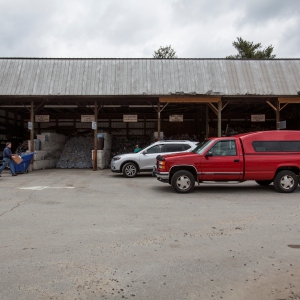Loon eggs tell a story of forever chemicals in Squam Lake
| Published: 09-06-2023 2:30 PM |
SANDWICH — Data collected from dozens of nonviable loon eggs points to high levels of “forever chemicals” and other similar contaminants in Squam Lake, which has been lauded for its pristine water quality. In 2021, the Loon Preservation Committee published a 38-page report covering their findings and shared it with the New Hampshire Department of Environmental Services in hopes of promoting more testing for “forever chemicals” throughout the state.
“LPC recognizes that state agency funding for testing of contaminants is limited and that contaminants testing is both complex and expensive,” the report reads. “However, we believe long-term systematic testing of high trophic-level lake wildlife is needed to address this issue and gain a better understanding of the extent, levels, and potential impact of contaminants in New Hampshire’s lakes.”
The report noted the effect of these contaminants on loons are still unknown, but concluded that 60% of the eggs tested “exceeded levels documented to cause negative health or reproductive effects in other bird species in one or more contaminant classes.”
“In 2004 and 2005 there was a nearly 50% decline in the number of paired loon adults on Squam Lake,” said Tiffany Grade, an LPC biologist and co-author of the report. “It was the largest, single-year decline we had seen in the loon population since LPC started working. We were founded in 1975.”
In short, there were 16 pairs of loons in 2004, which dropped to nine in 2005. The exact cause has not been determined.
“That was followed by years of almost total reproductive failure on the lake,” Grade said. “In 2007, we bottomed out with only a single surviving chick on the lake and that had not happened since 1978, when loons were declared a threatened species.”
Whether or not the higher levels of contamination contributed to the population drop is not 100% clear.
“I think it may have [contributed],” Grade said. “It wasn’t any one single thing that seems to have contributed to the decline. Loons in New Hampshire are dealing with a lot: fishing tackle, recreational disturbance, shoreline development, climate change.” Grade continued, “But the two things that really set Squam back during those years is that the eggs did seem to have higher levels of contamination than other eggs we had tested at the time, even as much as five or six times higher.”
Article continues after...
Yesterday's Most Read Articles
 UNH faculty and students call on university police chief to resign following his alleged assault on a student
UNH faculty and students call on university police chief to resign following his alleged assault on a student
 Steeplegate project to reopen to public comment as developer seeks to reduce required parking
Steeplegate project to reopen to public comment as developer seeks to reduce required parking
 Opinion: NH should support SB 553
Opinion: NH should support SB 553
 A turbulent 50-year history: Inside the rise and fall of a tiny Catholic college in Warner
A turbulent 50-year history: Inside the rise and fall of a tiny Catholic college in Warner
 Hopkinton tries to nab out-of-town trash bandits
Hopkinton tries to nab out-of-town trash bandits
 Lawyers and lawmakers assert the Department of Education is on the verge of violating the law
Lawyers and lawmakers assert the Department of Education is on the verge of violating the law
The idea of using bird eggs as measuring devices goes back to the 1970s, when eagle and peregrine falcon eggs were measured to detect levels of DDT.
“It’s not necessarily a new method,” Grade said of the loon study, “but loons for this area are just really uniquely suited to this study.”
Fortunately, Squam has not seen such a drastic year for loon populations since, but the rapid downturn sparked further study. Grade explained the chemical spikes seen in eggs may take a few years to appear, meaning any contamination that occurred in 2023 would not start showing up until 2025.
“One of the things we did to better understand it was we took some nonviable eggs from failed nests for research,” Grade said, adding that the LPC carefully selects their eggs, and is permitted to do so. “We sent some of the eggs in for chemical testing, and what we found was essentially a chemical cocktail,” Grade continued. “It was a mix of emerging contaminants like PFAS, as well as BDE flame retardants, as well as legacy contaminants, things that have been banned for decades like PCBs, DDT, other insecticides, things like that.”
BDE is found in a wide selection of products, from mattresses to consumer electronics. PFAS is found in an even wider selection of products including nonstick cookware, firefighting foam, fast food wrappers, cosmetics, stain-resistant fabric and outdoor gear. PFAS is so prevalent that there are now unsafe levels of the substance in all rainwater on earth. Exposure to these types of chemicals has been connected to fertility issues, liver damage and even certain types of cancers.
Grade said BDE stood out particularly on Squam, while PFAS levels were lower. Three possible contamination sites along tributaries that feed the lake have been identified, but none qualified for full remediation efforts. One site, according to Grade, was once an apple orchard, and could explain how higher levels of the insecticide DDT appeared in the lake.
“There was a report submitted to us ... we opened a site evaluation project and reviewed the data submitted to us that was in relation probably to the apple orchard,” said Jeffery Marts, administrator of DES’s Hazardous Waste Remediation Bureau. “We looked at data and compared it to soil remediation values and our rules. Pesticides, if they’re applied consistently to their labeling, that’s considered background concentration and it may not qualify for remediation. I think in that case it may not have exceeded any of our soil remediation standards.”
While the contamination level didn’t constitute remediation efforts, Marts said DES had recently finished a statewide effort with the U.S. Geological Survey to analyze PFAS contamination in surface soil.
“What we found is that PFAs are present in nearly every soil sample from 0 to 6 inches at 100 locations across the state,” Marts said. “That initiative was really driven by the fact that we had adopted lower standards for these compounds in drinking water. It was also directed by the legislature to develop soil remediation standards to protect groundwater. That drove the investigation into soil statewide.”
The final report of Grade’s findings was published in 2021, after LPC tested 81 common loon eggs from 24 lakes across New Hampshire for both legacy and emerging contaminants. Of those eggs, 53 were from Squam Lake and ranged in dates from 1993 to 2019.
High levels of PFAS and other chemicals does not directly translate to poor water quality. Instead, it affects the health of the organisms that call the lake home.
“Loons are getting these contaminants from their fish, it’s not a water issue,” Grade explained. “This is a food web issue. Those things need to go up the food chain to get to the egg.”
Levels grew high enough that DES issued a fish consumption advisory in Squam Lake, active since 2020, that dictates limits based on the size of the fish and the age of the consumer. Grade said she personally would not eat a fish from Squam Lake.
Despite these contaminants appearing in loon eggs, Squam Lake still has some of the best water quality in the country. The Environmental Protection Agency’s 2017 National Lake Assessment ranked Squam in the top 10% of lakes from a quality standpoint. The lake has also never had a cyanobacteria algae bloom.
“The first thing is that 90% of the watershed is densely forested,” said Cole Beale, director of conservation at the Squam Lakes Association about why Squam has never had a bloom. “There’s very little development around the shoreline. And areas that are developed are owned by the same people that have owned them forever, and they care about the water.”
Dense forest and other natural surroundings can play an important role in absorbing excess sediment and nutrients that cause blooms. Forever chemicals like PFAS and BDES, however, can circumvent these natural barriers by entering the water through rain or runoff from sites like those described by Grade.
The origin of these contaminants has yet to be pinpointed.
“We are trying to get to the bottom of this issue here on Squam,” Grade said. “We are working with the Squam Lakes Association in partnership and we’ve been talking to some environmental consulting firms. We’ve identified these sites, what we need to do is just map the extent of contamination in these areas so that we can understand what the options may or may not be for mitigating these contaminants.”
While there are emerging ways to potentially separate contaminants from soil and water, such methods are still being explored and are currently not feasible on a large scale.
“There are methods that can remove it, but take the practicability of treating all the soil in the state,” Marts said. “Once we adopt the standard, there’s emerging tech to address this, and a lot of scientists and engineers looking at this problem to develop solutions.”
These articles are being shared by partners in The Granite State News Collaborative.


 Following budget cut, Pembroke revisits future of elementary school re-build
Following budget cut, Pembroke revisits future of elementary school re-build Granite Geek: Free government software for taxes – what could go wrong? (Not much, as it turns out)
Granite Geek: Free government software for taxes – what could go wrong? (Not much, as it turns out) To snuff out cancer, NH firefighters seek regular screenings
To snuff out cancer, NH firefighters seek regular screenings New Hampshire jury finds state liable for abuse at youth detention center and awards victim $38M
New Hampshire jury finds state liable for abuse at youth detention center and awards victim $38M
